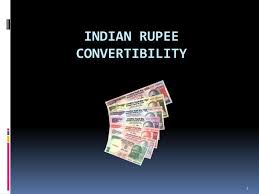
Say No To Rupee Convertibility
Government of India is proceeding step-by-step toward making the rupee fully convertible into foreign currencies. That would make it possible for Indian citizens to buy dollars for capital investment in the New York Stock Exchange. Presently it is possible to buy dollars only for current transactions such as education, business travel and purchase of magazines etc.
We have foreign exchange reserves of more than 100 billion dollars and it is increasing everyday. Making the rupee convertible would bring forth demand for these dollars from private investors and take away the pressure from the Reserve Bank to buy the dollars endlessly. But we must take a look at the long-term consequences of this policy. There are three ways in which the dollars brought by foreign investors can be used. One, the rupee can be made convertible so that our citizens can purchase them for outward capital flows from India. The East Asian countries adopted this policy in the nineties. They got into crisis because of this policy. Their citizens too had started sending their savings abroad when foreign investors began to withdraw their money. That had led to a run on their currencies and a steep devaluation of the same.
The second solution is that the Reserve Bank continues to buy the dollars and accumulate foreign exchange reserves. This policy has been adopted by China. This policy is also harmful because we would be buying dollars the value of which is certain to fall tomorrow if not today. We would have to incur heavy losses, as the value of our forex reserves will decline along with that of the dollar.
The third solution is to allow the price of rupee to increase. That would lead to less inflow of dollars. The problem here is that a strong rupee would adversely affect our exports. The choice then is between three potential problems: (1) due to outflow of our money; (2) due to decline in the value of our forex reserves; and (3) due to problems for our exporters. The three choices can be best examined in the light of East Asian and Chinese experience.
The manufacturing activity of products like cars, textiles and toys shifted to the Asian Tigers, as they were then called, in a big way in the nineties. American companies like General Motors were closing down their plants in the US and establishing new ones in Thailand. This was leading to a huge inflow of dollars into East Asia just as there is a huge inflow in India today due to the shifting of services known as 'outsourcing'. Those countries had large forex reserves and were confident of their ability to handle foreign capital flows just as our Government is today. Those countries had made their currencies convertible just as our government is planning to do now.
The situation of those countries changed dramatically in 1997. The demand for their textiles, cars and toys in the industrial countries ebbed a little. That led to a reduction in the inflow of dollars into those countries. The foreign investors became bearish and started withdrawing their money. The citizens of those countries followed the footsteps of the foreign investors. Soon the large forex reserves disappeared and their currencies faced a steep devaluation. These Asian tigers have still not recovered from that crisis even after six years. This shows the dangers of making the rupee convertible on the basis of large forex reserves. The experience of Latin American countries like Argentina also points out to this danger. That country had made its currency convertible. But the perception of foreign investors changed and ultimately it had to suspend convertibility. Our 'huge' forex reserves can similarly disappear in a short time if the rupee is made convertible.
China has followed the second policy. She has not made the Yuan renminbi convertible. Chinese citizens do not have the right to buy dollars for making investment in the New York Stock Exchange. Manufacturing activity is increasing in China today in the same manner that it did in East Asian countries in the nineties. This is leading to huge amount of foreign capital inflows into China. The Central Bank of China is purchasing these dollars and investing them in the US to augment her forex reserves. The Bank buys as many dollars as necessary to keep the value of the dollar stable. This is beneficial for the Chinese exporters. The result is that China's exports are rising and imports are comparably less. This is leading to greater income of dollars from exports and less demand for the dollars for imports. The Central Bank is buying these excess dollars and balancing the books. But this formula can be successful only as long as the Central Bank is willing to buy all the excess dollars.
Obviously there are limits to this policy because the trade surplus will continue to rise as long as China keeps the value of the renminbi low. The fundamental problem is that the price of goods produced in China is less and that makes her economy competitive. Her exports are large and imports are less. This leads to large receipt of dollars from exports and less demand for them for imports. In a free market the value of the renminbi should increase, the exports should reduce, imports should increase and the books should get balanced. But the Government of China refuses to acknowledge this reality. Instead of allowing the renminbi to rise it is buying the dollars and accumulating huge forex reserves. These reserves are like a cooker the pressure of which is continually rising and can explode any day.
Both these policies are not durable. Instead we must allow the rupee to rise against the dollar. This will spontaneously lead to reduced inflows of the dollar. Indeed the problems of our exporters would become worse. But that is the mark of a strong economy. A strong rupee means that we can produce goods at low price. It means that we can obtain high prices for small quantities of our goods. That must be our target. We should not forget that a weak rupee was seen as an indicator of a weak economy. Contrariwise a strong rupee should be seen as a strong Indian economy.
We have been misled by the slogan of export-oriented growth. 'Exports' mean that we give away more of our resources. We pack our precious groundwater into wheat and sugar and export it. That is utter foolishness. Instead of looking for larger exports we must develop our domestic markets for higher growth rate.
The experience of the East Asian countries shows the dangers of making our Currency convertible on the strength of short-term increase in forex reserves. The ever-increasing forex reserves of China signal the dangers of buying dollars in unlimited quantities. We must chart our own course and let the' rupee appreciate and see fewer exports as an achievement.


